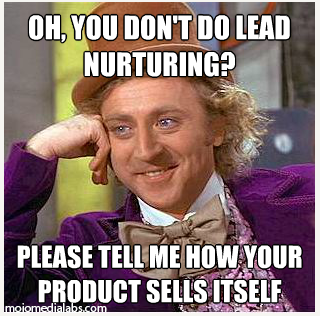- Share MarketingProfs B2B Forum: 3 Changes You Can Make Today on Facebook
- Share MarketingProfs B2B Forum: 3 Changes You Can Make Today on Twitter
- Share MarketingProfs B2B Forum: 3 Changes You Can Make Today on Linkedin
- Share MarketingProfs B2B Forum: 3 Changes You Can Make Today via email
MarketingProfs put on a great conference last week, gathering over 850 B2B marketers for the 2014 B2B Forum. We traveled a few minutes down the street from our Boston office to attend the event, which was full of learning, networking, and listening.
My coworker Alex Barca and I had the chance to attend for the first time and participate in some thought-provoking sessions hosted by Mark O’Brien, Jennifer Sable Lopez, Heidi Cohen, Lee Odden, Gini Dietrich, Andy Crestodina, Pam Didner, Doug Kessler, Joe Pulizzi, Jeannine Rossignol, and Jason Miller.
Here are the three main action items we think any B2B marketer can take away from the 2 ½ day conference:
1. Implement Content Marketing in Small Steps
Although the event was about all of B2B marketing, many of the speakers gave great advice specifically about content marketing and how to implement content strategy in large organizations. Here are some of their tips:
Start Small and Share Success
Many marketing professionals who want to implement content marketing within their organization face reluctance from executives who don’t want to shake up the traditional marketing model. Joe Pulizzi, founder of Content Marketing Institute, suggested starting small, with a pilot program such as a blogging program. Then, after 6-12 months, show executives key changes in lead quality and quantity that have come from content marketing.
Strategy Must Be Central
Speakers such as Pulizzi and Jeannine Rossignol, VP of Marketing, Xerox Global services, emphasized the importance of strategy. Pulizzi mentioned that many large organizations are creating content at random without a documented strategy. He said documenting this strategy is crucial in order to ensure content is consistent and working towards the same goal across all divisions. It will additionally help prove to reluctant executives that content has long-term staying power.
A major part of this strategy is building out an editorial calendar for the coming months. If you need help mapping out your plan, check out our list of editorial calendar templates.
Don’t Just Enable Salespeople – Empower Them
In order to prove the power of content marketing, think about aligning it more closely with sales. Help salespeople by creating assets they can use as discussion points with prospects such as best practice tips or checklists. Also, accompany salespeople on calls and meetings to better understand their job and needs (and get further insight into potential buyers.) For more information about sales enablement, see this presentation from Curata CMO Michael Gerard.
2. Optimize Tools for Proper Lead Development
Mark O’Brien, CEO of Newfangled, presented on how to create more and better web leads using a lead development ecosystem, which is a system primarily comprised of lead creation and lead nurturing. Some of the highlights from his presentation include:
The Key Marketing Benchmarks
O’Brien started off his talk by providing key benchmarks for a successful lead development initiative. After doing some research, he found that the most successful companies should be able to:
- Create around 3,000 words per month of educational, valuable content on their blog;
- Have at least 5,000 contacts in their database;
- Attract 2,000 visitors per month to their site;
- Execute at least 25 conversions (leads to sales opportunities) per week;
- And have 40% of traffic come from organic, non-branded search.
Tools Needed for a Lead Development Ecosystem
In order to have the most effective and efficient lead development ecosystem, O’Brien said that the proper tools must first be in place. Right from the get-go, O’Brien told all of us that in order to create an effective lead development ecosystem, website, CRM, and marketing automation must be seamlessly integrated.
Attract, Inform, and Engage
With the proper tools in place, B2B marketers should then be able to create a system that attracts, informs, engages, and nurtures leads. O’Brien stated that the foundation of a successful lead development ecosystem needs to be surrounded around a unique value proposition. How are you going to attract users to your website?
O’Brien emphasized that this is something marketers must think about and if they are unable to offer a unique value proposition, then their website is not meeting the most basic need of their audience.
One of my favorite points during his presentation was when he said that if marketers are able to offer a unique value proposition — something which explains what benefit they provide, and how they do it “uniquely” — the stigma of buying lists will be irrelevant.
Prepare Your Website
In addition to drawing people in, the website must also be ready to inform. This is where educational, valuable content marketing comes into the process. O’Brien says that most prospects do not land on the homepage for their first visit. Instead, the majority of these prospects arrive on many of the other pages to the site because they have been looking for an answer to a specific question (via organic, non-branded search). By offering unique, expert, and indexable content on each and every page, B2B marketers will be not only attracting, but also informing their audience.
The content needs to be prepped and ready to go because marketers are intuitively guiding their prospects to their site and they have no idea what page they may land on. Because of this, the website must also engage. O’Brien gave the audience a rule of thumb for achieving proper engagement when he stated that every single page should have 1-3 points of engagement (e.g., call-to-actions, forms, and links to other content).
How to Nurture
After attracting, informing, and engaging their audience, the last step for a successful lead development ecosystem is to implement marketing automation. O’Brien says that marketing automation is able to do the nurturing for marketers using key elements such as email deliverability, automated programs, progressive profiling, and lead scoring. Ensuring that B2B marketers have enough content to feed into their nurture engine is a point that should not be forgotten. A tactic such as segmenting contacts in the database (via industry, gender, etc.) can help deliver the right content to the right audience.
One of the best tips that O’Brien gave to the crowd is that marketers need to start taking advantage of progressive profiling — displaying new form fields to prospects based on the data previously collected on them — because it allows them to cater to each and every prospect on each and every page. In fact, O’Brien suggests that they should treat every page as if it is a landing page, and if they do that, they are more likely to engage their leads.
If B2B marketers are able to incorporate each and every one of the above points into their business model, they will be on their way to creating a successful lead development ecosystem.
3. Harness the Power of Social Media
Just like Harry Potter honing in on his magic skills, a good marketer knows how to untap the many powers of social media. Here are some of the key tips I took away from the conference:
You don’t need to be on every network, just the right networks.
Jennifer Sable Lopez, Director of Community at Moz, kicked off her presentation on social analytics by telling marketers they shouldn’t feel like they have to conquer every social network. Instead, she said to focus on building a following within networks where customers and prospects are active.
Measure, Optimize and Repeat
Sable Lopez asked the audience who has ever Googled a question such as “What is the best time of day to tweet?” Or “What is the best time of day to post on Facebook?” Admittedly, I raised my hand along with the majority of the room. Sable Lopez said that although everybody does this, we should instead rely on our own data to figure out the best times to post, as it is different for every business and community. Sable suggested the following methods for measuring and optimizing social media posts:
- Follow your followers. Use tools such as FollowerWonk to figure out when your followers are active on various social media platforms. Then, see if your activity aligns with theirs. If it doesn’t, make this change ASAP.
- Look back to see what’s worked and what hasn’t. Measure engagement on different types of posts from the past and look for patterns. (For example, you may find that your tweets that get the most retweets are between the hours of 12-4 p.m. EST). Also, use A/B testing to see what types of posts (e.g., visual vs. text) resonate best with your audience.
- Keep a spreadsheet of weekly engagement metrics (such as percentage of retweets or shares per post). As you ramp up social media efforts and experiment with new methods, use this spreadsheet to track progress. To compute these metrics use built-in tools such as Twitter Analytics and Facebook Insights as well as third party tools such as SimplyMeasured (which has a fairly robust list of free tools).
For more information about social media measurement, see Sable Lopez’s full presentation:
Use Employee Advocacy
Social Media is a powerful tool for content promotion, but are you using all of your resources?
Many companies don’t consider their own employees as sources of content promotion – but that is the very concept behind employee advocacy.
Speaker Neal Schaffer urged marketers to use each of their employees as built-in social shares. If incentivizing employees to share content seems like a battle you will not win, he suggests using tools such as GaggleAMP or SocialChorus, which automate the process and make sharing updates easy for employees.
Explore the Value of LinkedIn
For years, many people only saw LinkedIn as a place to find jobs and post job listings. But, according to Jason Miller, Senior Manager of Content and Social for LinkedIn, pieces of content gets 7 times more page views than job pages on LinkedIn. Because 1/3 of all professionals in the world are on LinkedIn, this is a great platform to promote and publish content.
Use LinkedIn to:
- Share existing content such as blog posts through company status updates, similar to how you promote content though any other social network.
- Position executives as industry thought leaders with the LinkedIn pulse blogging platform. Create original content or repurpose existing blog posts. For example, we have recently repurposed several blog posts for LinkedIn Pulse. This post about SEO performed quite well on LinkedIn (3,962 page views and counting!) for Curata CEO Pawan Deshpande after it was updated to include Google’s recent change to Panda 4.0.
Use this guide as you begin to plan and prioritize your marketing strategy for the coming months. For more information about building a content marketing strategy, download our Content Marketing Tactics Planner below.












